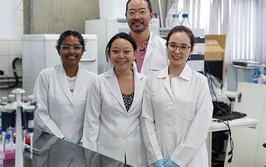Multi-residue pesticide screening in cereals using GC-Orbitrap mass spectrometry

contributed by Thermo Fisher Scientific |
Goal
To demonstrate the performance of the Thermo Scientific™ Exactive™ GC Orbitrap™ mass spectrometer for the routine analysis of GC-amenable pesticides in cereals (wheat, barley, oat, rye and rice).
Introduction
Pesticides are used to improve cereal crop yields and to minimize degradation during storage and processing. However, the widespread use of pesticides and the potential for residues to remain on the final product is of concern to consumers and to governments whose responsibility it is to ensure a safe food supply. Consequently, legislation has been introduced to protect consumers from exposure to contaminated foods.1 Pesticide application to cereal crops is regulated by international organizations, and maximum residue levels (MRLs) are set for each pesticide/commodity combination. In the EU, if no substantive MRL has been set, a default MRL value of 0.01 mg/kg is usually applied.
Log in or register to read this article in full and gain access to The Analytical Scientist’s entire content archive. It’s FREE!

















